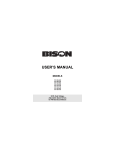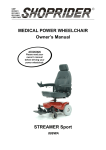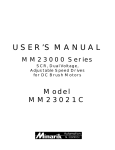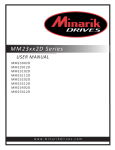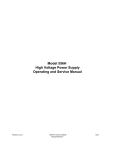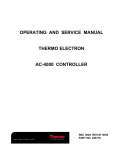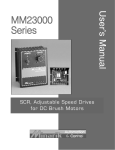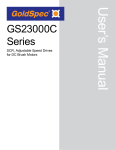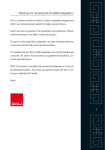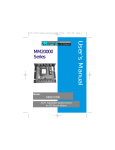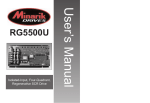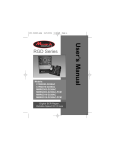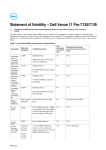Download USER`S MANUAL
Transcript
USER’S MANUAL MM23002D Series SCR, Dual Voltage, Adjustable Speed Drives for PM DC Brush Motors Copyright © 2006 by Minarik Drives All rights reserved. No part of this manual may be reproduced or transmitted in any form without written permission from Minarik Drives. The information and technical data in this manual are subject to change without notice. Minarik Drives and its Divisions make no warranty of any kind with respect to this material, including, but not limited to, the implied warranties of its merchantability and fitness for a given purpose. Minarik Drives and its Divisions assume no responsibility for any errors that may appear in this manual and make no commitment to update or to keep current the information in this manual. Printed in the United States of America. i Safety Warnings • This symbol denotes an important safety tip or warning. Please read these instructions carefully before performing any of the procedures contained in this manual. • DO NOT INSTALL, REMOVE, OR REWIRE THIS EQUIPMENT WITH POWER APPLIED. Have a qualified electrical technician install, adjust and service this equipment. Follow the National Electrical Code and all other applicable electrical and safety codes, including the provisions of the Occupational Safety and Health Act (OSHA), when installing equipment. • Reduce the chance of an electrical fire, shock, or explosion by proper grounding, over-current protection, thermal protection, and enclosure. Follow sound maintenance procedures. It is possible for a drive to run at full speed as a result of a component failure. Minarik strongly recommends the installation of a master switch in the main power input to stop the drive in an emergency. Circuit potentials are at 115 VAC or 230 VAC above earth ground. Avoid direct contact with the printed circuit board or with circuit elements to prevent the risk of serious injury or fatality. Use a non-metallic screwdriver for adjusting the calibration trimpots. Use approved personal protective equipment and insulated tools if working on this drive with power applied. ii Contents Safety Warnings i Specifications 1 Model Number Suffix Definitions 2 Dimensions 3 Installation 7 Chassis drives . . . . . . . . . . . . . . . . . . . . . . . . . . . . . . . . . . . . . . . . . . . . . . . . . .7 Mounting . . . . . . . . . . . . . . . . . . . . . . . . . . . . . . . . . . . . . . . . . . . . . . . . . . . . .7 Wiring . . . . . . . . . . . . . . . . . . . . . . . . . . . . . . . . . . . . . . . . . . . . . . . . . . . . . . .8 Shielding guidelines . . . . . . . . . . . . . . . . . . . . . . . . . . . . . . . . . . . . . . . . . . . .9 Speed adjust potentiometer . . . . . . . . . . . . . . . . . . . . . . . . . . . . . . . . . . . . .10 Line fusing . . . . . . . . . . . . . . . . . . . . . . . . . . . . . . . . . . . . . . . . . . . . . . . . . .11 Heat sinking . . . . . . . . . . . . . . . . . . . . . . . . . . . . . . . . . . . . . . . . . . . . . . . . .12 Connections . . . . . . . . . . . . . . . . . . . . . . . . . . . . . . . . . . . . . . . . . . . . . . . . .12 Power, fuse and motor connections . . . . . . . . . . . . . . . . . . . . . . . . . . . .13 Motor . . . . . . . . . . . . . . . . . . . . . . . . . . . . . . . . . . . . . . . . . . . . . . . . . . . .13 Power input . . . . . . . . . . . . . . . . . . . . . . . . . . . . . . . . . . . . . . . . . . . . . . .13 Line fuse . . . . . . . . . . . . . . . . . . . . . . . . . . . . . . . . . . . . . . . . . . . . . . . . .13 Master power switch . . . . . . . . . . . . . . . . . . . . . . . . . . . . . . . . . . . . . . . . . .14 Alternate speed adjust potentiometer connections . . . . . . . . . . . . . . . . . . .14 Voltage follower . . . . . . . . . . . . . . . . . . . . . . . . . . . . . . . . . . . . . . . . . . . . . .16 Cased drives . . . . . . . . . . . . . . . . . . . . . . . . . . . . . . . . . . . . . . . . . . . . . . . . . .17 Mounting (NEMA 1 enclosures) . . . . . . . . . . . . . . . . . . . . . . . . . . . . . . . . . .17 Mounting (NEMA 12/4/4X enclosures) . . . . . . . . . . . . . . . . . . . . . . . . . . . . .18 Heat sinking . . . . . . . . . . . . . . . . . . . . . . . . . . . . . . . . . . . . . . . . . . . . . . . . .19 Line fusing . . . . . . . . . . . . . . . . . . . . . . . . . . . . . . . . . . . . . . . . . . . . . . . . . .19 All drives . . . . . . . . . . . . . . . . . . . . . . . . . . . . . . . . . . . . . . . . . . . . . . . . . . . . . .20 Operation 22 Switch settings . . . . . . . . . . . . . . . . . . . . . . . . . . . . . . . . . . . . . . . . . . . . . . . . .23 Before applying power . . . . . . . . . . . . . . . . . . . . . . . . . . . . . . . . . . . . . . . . . . . .24 Speed Mode . . . . . . . . . . . . . . . . . . . . . . . . . . . . . . . . . . . . . . . . . . . . . . . . .25 Torque Mode . . . . . . . . . . . . . . . . . . . . . . . . . . . . . . . . . . . . . . . . . . . . . . . . .25 Speed Mode Startup . . . . . . . . . . . . . . . . . . . . . . . . . . . . . . . . . . . . . . . . . . . . .27 MM23002 and MM23012 . . . . . . . . . . . . . . . . . . . . . . . . . . . . . . . . . . . . . .27 MM23102, MM23112, MM23402 and MM23412 . . . . . . . . . . . . . . . . . . . . .27 MM23202 and MM23212 . . . . . . . . . . . . . . . . . . . . . . . . . . . . . . . . . . . . . . .28 iii Starting and Stopping Methods . . . . . . . . . . . . . . . . . . . . . . . . . . . . . . . . . . . . .29 Line starting and line stopping . . . . . . . . . . . . . . . . . . . . . . . . . . . . . . . . . . .29 Inhibit terminals . . . . . . . . . . . . . . . . . . . . . . . . . . . . . . . . . . . . . . . . . . . . . .30 Decelerating to minimum speed . . . . . . . . . . . . . . . . . . . . . . . . . . . . . . . . .32 Dynamic braking . . . . . . . . . . . . . . . . . . . . . . . . . . . . . . . . . . . . . . . . . . . . . .33 Dynamic brake resistor value . . . . . . . . . . . . . . . . . . . . . . . . . . . . . . . . .33 Calibration 35 MIN SPD . . . . . . . . . . . . . . . . . . . . . . . . . . . . . . . . . . . . . . . . . . . . . . . . . . . . .37 MAX SPD . . . . . . . . . . . . . . . . . . . . . . . . . . . . . . . . . . . . . . . . . . . . . . . . . . . . .37 TORQUE . . . . . . . . . . . . . . . . . . . . . . . . . . . . . . . . . . . . . . . . . . . . . . . . . . . . . .38 IR COMP . . . . . . . . . . . . . . . . . . . . . . . . . . . . . . . . . . . . . . . . . . . . . . . . . . . . . .39 ACCEL . . . . . . . . . . . . . . . . . . . . . . . . . . . . . . . . . . . . . . . . . . . . . . . . . . . . . . .40 DECEL . . . . . . . . . . . . . . . . . . . . . . . . . . . . . . . . . . . . . . . . . . . . . . . . . . . . . . .41 Torque Mode Calibration . . . . . . . . . . . . . . . . . . . . . . . . . . . . . . . . . . . . . . . . . .42 Application Notes 44 Multiple fixed speeds . . . . . . . . . . . . . . . . . . . . . . . . . . . . . . . . . . . . . . . . . . . .44 Adjustable speeds using potentiometers in series . . . . . . . . . . . . . . . . . . . . . .45 Independent adjustable speeds . . . . . . . . . . . . . . . . . . . . . . . . . . . . . . . . . . . .46 RUN / JOG switch . . . . . . . . . . . . . . . . . . . . . . . . . . . . . . . . . . . . . . . . . . . . . .47 Leader-follower application . . . . . . . . . . . . . . . . . . . . . . . . . . . . . . . . . . . . . . . .49 Single speed potentiometer control of multiple drives . . . . . . . . . . . . . . . . . . .50 Reversing . . . . . . . . . . . . . . . . . . . . . . . . . . . . . . . . . . . . . . . . . . . . . . . . . . . . .51 Reversing with a DIGI-LOK® controller . . . . . . . . . . . . . . . . . . . . . . . . . . . . . . .52 Troubleshooting 53 Before troubleshooting . . . . . . . . . . . . . . . . . . . . . . . . . . . . . . . . . . . . . . . . . . .53 Diagnostic LEDs . . . . . . . . . . . . . . . . . . . . . . . . . . . . . . . . . . . . . . . . . . . . . . . .54 Power (PWR): . . . . . . . . . . . . . . . . . . . . . . . . . . . . . . . . . . . . . . . . . . . .54 Current Limit (CURR LIMIT or CL): . . . . . . . . . . . . . . . . . . . . . . . . . . . .54 Functional Diagrams . . . . . . . . . . . . . . . . . . . . . . . . . . . . . . . . . . . . . . . . . . . . .58 Replacement Parts . . . . . . . . . . . . . . . . . . . . . . . . . . . . . . . . . . . . . . . . . . . . . .61 Certificate of Compliance 63 Line Filters . . . . . . . . . . . . . . . . . . . . . . . . . . . . . . . . . . . . . . . . . . . . . . . . . . . .64 Armature Filters . . . . . . . . . . . . . . . . . . . . . . . . . . . . . . . . . . . . . . . . . . . . . . . . .65 Unconditional Warranty inside back cover iv Illustrations Figure Figure Figure Figure Figure Figure Figure Figure Figure Figure Figure Figure Figure Figure Figure Figure Figure Figure Figure Figure Figure Figure Figure Figure Figure Figure Figure Figure Figure 1. MM23002D and MM23012D Dimensions . . . . . . . . . . . . . . . . . . . . . . . .3 2. MM23102D, MM23112D, MM23202D, and MM23212D Dimensions . . .4 3. MM23402D and MM23412D Dimensions . . . . . . . . . . . . . . . . . . . . . . . .5 4. Heat Sink Dimensions . . . . . . . . . . . . . . . . . . . . . . . . . . . . . . . . . . . . . . .6 5. Speed Adjust Potentiometer . . . . . . . . . . . . . . . . . . . . . . . . . . . . . . . . . .10 6. Chassis Drive Connections . . . . . . . . . . . . . . . . . . . . . . . . . . . . . . . . . .15 7. Voltage Follower Connections . . . . . . . . . . . . . . . . . . . . . . . . . . . . . . . .16 8. Cased Drive Connections . . . . . . . . . . . . . . . . . . . . . . . . . . . . . . . . . . .21 9. Voltage Switches . . . . . . . . . . . . . . . . . . . . . . . . . . . . . . . . . . . . . . . . . .23 10. J503 SPEED/TORQUE Jumper Settings . . . . . . . . . . . . . . . . . . . . . . .26 11. J503 SPEED/TORQUE Jumper Location . . . . . . . . . . . . . . . . . . . . . .26 12. INHIBIT Terminals . . . . . . . . . . . . . . . . . . . . . . . . . . . . . . . . . . . . . . . .30 13. Inhibit Personality Configuration . . . . . . . . . . . . . . . . . . . . . . . . . . . . .31 14. Run/Decelerate to Minimum Speed Switch . . . . . . . . . . . . . . . . . . . . .32 15. Dynamic Brake Connection . . . . . . . . . . . . . . . . . . . . . . . . . . . . . . . . .34 16. Calibration Trimpot Layout . . . . . . . . . . . . . . . . . . . . . . . . . . . . . . . . . .36 17. Recommended Torque and IR COMP Settings . . . . . . . . . . . . . . . . .42 18. Multiple Fixed Speeds . . . . . . . . . . . . . . . . . . . . . . . . . . . . . . . . . . . . .43 19. Adjustable Fixed Speeds Using Potentiometers in Series . . . . . . . . . .44 20. Independent Adjustable Speeds . . . . . . . . . . . . . . . . . . . . . . . . . . . . .45 21. RUN / JOG Switch Connection to Inhibit Plug . . . . . . . . . . . . . . . . . . .46 22. RUN / JOG Switch Connection to Speed Adjust Potentiometer . . . . .47 23. Leader-Follower Application . . . . . . . . . . . . . . . . . . . . . . . . . . . . . . . . .48 24. Single Speed Potentiometer Control of Multiple Drives . . . . . . . . . . . .49 25. Reversing Circuit Connection . . . . . . . . . . . . . . . . . . . . . . . . . . . . . . .50 26. Reversing with a DLC600 . . . . . . . . . . . . . . . . . . . . . . . . . . . . . . . . . .52 27. Diagnostic LED Locations . . . . . . . . . . . . . . . . . . . . . . . . . . . . . . . . . .54 28. MM23000 Series Block Diagram . . . . . . . . . . . . . . . . . . . . . . . . . . . . .58 29. MM23102, MM23112, MM23402 and MM23412 Terminal Block Connections . . . . . . . . . . . . . . . . . . . . . . . . . . . . . . . . .59 Figure 30. MM23202 and MM23212 Terminal Block Connections . . . . . . . . . . . .60 Tables Table Table Table Table 1. 2. 3. 4. Recommended Line Fuse Sizes . . . . . . . . . . . . . . . . . . . . . . . . . . . . . . .11 Replacement Parts . . . . . . . . . . . . . . . . . . . . . . . . . . . . . . . . . . . . . . . . .61 Corcom® Filters . . . . . . . . . . . . . . . . . . . . . . . . . . . . . . . . . . . . . . . . . . .64 Minarik® Filters . . . . . . . . . . . . . . . . . . . . . . . . . . . . . . . . . . . . . . . . . . . .65 1 Specifications Model MM23012D MM23112D MM23212D MM23412D MM23002D † MM23102D ‡ MM23202D ‡ MM23402D Max. Armature Current (Amps DC) 1.5 HP Range with 115 VAC Applied 1/20–1/8 HP Range with 230 VAC Applied 1/10–1/4 5.0 1/8–1/2 1/4–1 10.0 1/8–1 1/4–2 Style Chassis NEMA 1 NEMA 1 NEMA 12/4/4X Chassis NEMA 1 NEMA 1 NEMA12/4/4X † Double maximum armature current and horsepower when drive is mounted on heat sink part number 223-0159. ‡ Double maximum armature current and horsepower when drive is mounted on heat sink part number 223-0174. AC Line Voltage 115 VAC or 230 VAC ±10%, 50/60 Hz, single phase Armature Voltage (115 VAC Input) 0–90 VDC Armature Voltage (230 VAC Input) 0–180 VDC Form Factor 1.37 at base speed Accel. Time Range (for 0–90 VDC Armature Voltage) 0.5–17 seconds (for 0–180 VDC Armature Voltage) 0.5–17 seconds Decel. Time Range (for 0-90 VDC Armature Voltage) coast to a stop–25 seconds (for 0–180 VDC Armature Voltage) coast to a stop–25 seconds Analog Input Voltage Range (input must be isolated; S1 to S2) 0–2.5 VDC Input Impedance (S1 to S2) 100K ohms Speed adjust potentiometer rating 10k ohm, 5W (5k ohms acceptable) Load Regulation 1% base speed or better 2 Vibration Safety Certification Ambient Temp. Range (chassis drive) Ambient Temp. Range (cased drive) 0.5G max (0–50 Hz) 0.1G max (>50 Hz) UL Recognized Component, file # E132235 CSA Certified Component, file # LR41380 CE Certificate of Compliance 10°C–55°C 10°C–40°C Model Number Suffix Definitions A: C: C-H: D: Basic drive Basic drive with current limit LED Basic drive with power supply header block. Basic drive with power supply header block, power and current limit LEDs, and torque mode. 3 Dimensions SCR501 D 502 S C R5 0 2 C503 R501 0.19 [5] R502 C505 MOV502 D503 D501 MOV501 L1 L2 C50 1 T501 115 SW501 IC502 IC501 230 3.58 [91] A2 C 502 SO501 SO502 + INH J 5 02 SW503 OUTPUT 1 1 3 A1 C504 SW502 1.75 [44] 4 J 50 1 S3 S2 S1 J503 1 5 C 506 POWER TQ LIMIT 0.74 [19] 0.64 [16] 3.80 [97] 4.30 [109] 0.19 [5] 1.60 [41] 1.28 [33] 0.96 [24] 3.80 [97] 4.30 [109] ALL DIMENSIONS IN INCHES [MILLIMETERS] Figure 1. MM23002D and MM23012D Dimensions 4 6.00 [152] 1.79 [45] 2.50 [64] 8.00 [203] 2.50 [64] 5.00 [127] THREE KEYHOLES FOR #10 SCREW ON BACK SIDE FOR MOUNTING 3.46 [88] 2.75 [70] 1.72 [44] 2.50 [64] TWO 0.88 [22] CONDUIT HOLES ON BOTTOM SIDE ALL DIMENSIONS IN INCHES [MILLIMETERS] Figure 2. MM23102D, MM23112D, MM23202D, and MM23212D Dimensions 5 6.90 [175] 6.30 [160] 0.87 [22] 7.76 [197] 8.20 [208] 6.00 [152] FOUR MOUNTING SLOTS 0.19 INCHES [5 MILLIMETERS] WIDE 4.50 [114] 3.70 [94] 2.25 [57] 0.13 [3] 2.50 [64] TWO 0.88 [22] CONDUIT KNOCKOUTS ON BOTTOM SIDE ALL DIMENSIONS IN INCHES [MILLIMETERS] Figure 3. MM23402 and MM23412 Dimensions 6 6.90 6.90 [175] [175] 6.30 [160] 6.30 [160] 5.90 [150] 5.90 [150] C A A BB MOUNTING SLOTS 0.19X X0.34 0.34[5 [5 X X 9] MOUNTING SLOTS 0.19 9] ALL DIMENSIONS IN INCHES [MILLIMETERS] ALL DIMENSIONS IN INCHES [MILLIMETERS] 1.00 [25] 1.00 [25] 0.13 [3] 0.13 [3] PART NO. DIM “A” DIM “B” DIM “C” 223-0159 4.40 [112] 223-0174 7.78 [198] Heat sinks sold separately. 3.00 [76] 6.00 [152] 0.7 [18] 0.89 [23] Figure 4. Heat Sink Dimensions 7 Installation Chassis drives Mounting Warning Do not install, rewire, or remove this control with power applied. Doing so may cause fire or serious injury. Make sure you have read and understood the Safety Warnings before attempting installation. The chassis must be earth grounded. Use a star washer beneath the head of at least one of the mounting screws to penetrate the anodized chassis surface and to reach bare metal. • Drive components are sensitive to electrostatic fields. Avoid contact with the circuit board directly. Hold the drive by the chassis only. • Mount the drive with its board in either a horizontal or vertical plane. Six 0.19 inch (5 mm) wide slots in the chassis accept #8 pan head screws. Fasten either the large base or the narrow flange of the chassis to the subplate. 8 Wiring Warning Do not install, remove, or rewire this equipment with power applied. Failure to heed this warning may result in fire, explosion, or serious injury. Circuit potentials are at 115 or 230 VAC above ground. To prevent the risk of injury or fatality, avoid direct contact with the printed circuit board or with circuit elements. Do not disconnect any of the motor leads from the drive unless power is removed or the drive is disabled. Opening any one motor lead may destroy the drive. • Use 18-24 AWG wire for speed adjust potentiometer wiring. Use 14–16 AWG wire for AC line (L1, L2) and motor (A1 and A2) wiring. 9 Shielding guidelines Warning Under no circumstances should power and logic leads be bundled together. Induced voltage can cause unpredictable behavior in any electronic device, including motor controls. As a general rule, Minarik recommends shielding of all conductors. If it is not practical to shield power conductors, Minarik recommends shielding all logic-level leads. If shielding is not practical, the user should twist all logic leads with themselves to minimize induced noise. It may be necessary to earth ground the shielded cable. If noise is produced by devices other than the drive, ground the shield at the drive end. If noise is generated by a device on the drive, ground the shield at the end away from the drive. Do not ground both ends of the shield. If the drive continues to pick up noise after grounding the shield, it may be necessary to add AC line filtering devices, or to mount the drive in a less noisy environment. 10 Speed adjust potentiometer Warning Be sure that the potentiometer tabs do not make contact with the potentiometer enclosure. Grounding the input will cause damage to the drive. On chassis drives, install the circular insulating disk between the panel and the 10K ohm speed adjust potentiometer. Mount the speed adjust potentiometer through a 0.38 inch (10 mm) hole with the hardware provided (Figure 5). Twist the speed adjust potentiometer wire to avoid picking up unwanted electrical noise. If potentiometer leads are longer than 18 inch (457 mm), use shielded cable. All cased controls come with the speed adjust potentiometer installed. MOUNT 0.38 IN (10 MOUNTTHROUGH THROUGHA A 0.38 IN.MM) (10HOLE MM) HOLE CW CW WIPER WIPER CCW CCW NUT NUT STAR STAR WASHER SPEED SPEED ADJUST POTENTIOMETER POTENTIOMETER WASHER INSULATING DISK DISK INSULATING POTTAB TAB ASSIGNMENTS POT ASSIGNMENTS PANEL PANEL Figure 5. Speed Adjust Potentiometer 11 Line fusing Minarik drives require an external fuse for protection. Use fast acting fuses rated for 250 VAC or higher, and approximately 150% of the maximum armature current. Fuse only the hot leg of the AC line that connects to L1 and leave L2 unfused when the AC line voltage is 115 VAC. Fuse both L1 and L2 when the AC line voltage is 230 VAC. Fuse blocks are included on cased drives only. Table 1 lists the recommended line fuse sizes. Table 1. Recommended Line Fuse Sizes 90 VDC Motor 180 VDC Max. DC Armature Horsepower Horsepower Current (amps) 1/20 1/10 0.5 1/15 1/8 0.8 1/8 1/4 1.5 1/6 1/3 1.7 1/4 1/2 2.6 1/3 3/4 3.5 1/2 1 5.0 3/4 1 1/2 7.6 1 2 10 AC Line Fuse Size (amps) 1 1.5 3 3 5 8 10 15 15 12 Heat sinking Model MM23002D requires an additional heat sink, Minarik part number 223-0159, when the continuous armature current is above 5 ADC. All other chassis drives have sufficient heat sinking in their basic configurations. Use a thermally conductive heat sink compound (such as Dow Corning® 340 Heat Sink Compound) between the drive chassis and heat sink surface for optimum heat transfer. Connections Warning Do not connect this equipment with power applied. Failure to heed this directive may result in fire or serious injury. For chassis drives, Minarik strongly recommends the installation of a master power switch in the voltage input line as shown in Figure 6 (page 15). The switch contacts should be rated at a minimum of 200% of motor nameplate current and 250 volts. 13 Power, fuse and motor connections Connect the power input leads, an external line fuse and a DC motor to the drive’s printed circuit board (PCB) as shown in Figure 6, page 15. Motor Connect a motor to PCB terminals A1 and A2. Ensure that the motor voltage rating is consistent with the drive’s output voltage. Power input Connect the AC line power leads to terminals L1 and L2, or to a double-pole, single-throw master power switch as shown in Figure 6, page 15 (recommended). Line fuse Wire an external line fuse between the stop switch (if installed) and the L1 terminal on the PCB. An additional line fuse should be installed on L2 if the input voltage is 230VAC. The line fuse(s) should be rated at 250 volts and 150 - 200% of maximum motor nameplate current. Refer to the Table 1 on page 11 for fuse ratings. 14 Master power switch If you use a chassis (uncased) drive, Minarik strongly recommends the installation of a master power switch in the voltage input line, as shown in Figure 6. The switch contacts should be rated at a minimum of 200% of motor nameplate current and 250 volts. Alternate speed adjust potentiometer connections Refer to Application Notes section (page 44) for additional speed adjust potentiometer connections. 15 SCR501 D 5 02 SC R5 02 C503 R501 R502 C505 MOV502 D503 D 50 1 MOV501 L1 L2 C50 1 T501 115 SW501 IC502 IC501 230 FUSE A2 C502 SO501 SO502 + INH 3 A1 SW503 OUTPUT 1 1 J 5 02 SW502 NOTE: DO NOT ADD FUSE TO L2 UNLESS INPUT VOLTAGE IS 230 VAC C5 0 4 4 J 50 1 S3 S2 S1 J 50 3 1 5 C5 0 6 POWER TQ LIMIT EMERGENCY STOP SWITCH MOTOR 10K OHM SPEED ADJUST POTENTIOMETER Figure 6. Chassis Drive Connections 16 Voltage follower Instead of using an external speed or torque adjust potentiometer, the drive may be wired to follow an analog input voltage signal that is isolated (Figure 7). The analog input voltage range is 0 2.5 VDC. Connect the signal input (+) to S2. Connect the signal common (-) to S1. Make no connection to S3. A potentiometer can be used to scale the analog input voltage. An interface device such as Minarik model PCM4, may be used to scale and isolate an analog input voltage. Isolated Signal Input Isolated Signal Common + – S2 S1 MM23000 Series Drive 0 - 2.5 VDC Figure 7. Voltage Follower Connections 17 Cased drives Mounting (NEMA 1 enclosures) NEMA 1 cased drives come with 0.88 inch (22 mm) conduit holes at the bottom of the case. The units may be vertically wall mounted or horizontally bench mounted using the three keyholes on the back of the case (see Figure 2, page 4). 1. For access to the keyholes and the terminal strip, remove the two screws from the front of the case by turning them counterclockwise. Grasp the front cover and lift it straight out. 2. Install the mounting screws in the three keyholes. 3. Install conduit hardware through the conduit holes at the bottom of the case. Connect external wiring to the terminal block. Refer to Figure 8 on page 21. 4. Reinstall the front cover. Avoid pinching any wires between the front cover and the case. 5. Replace the two screws to the front cover. Turn the screws clockwise to tighten. 6. Set the POWER switch to the OFF position before applying the AC line voltage. 18 Mounting (NEMA 12 / 4 / 4X enclosures) NEMA 12 / 4 / 4X cased drives come with two 0.88 inch (22 mm) conduit knockout holes at the bottom of the case. The units may be vertically wall mounted using the four 0.19 inch (5 mm) slotted holes on the attached heat sink (see Figure 3, page 5). For motor loads less than 5 ADC, the drive may be bench mounted horizontally, or operated without mounting. 1. Install the mounting screws. 2. For access to the terminal strip, turn the slotted screw on the front cover counterclockwise until it is free from the case. The right side of the cover is hinged to the case. Pull the slotted screw to open the case. 3. Carefully remove the conduit knockouts by tapping them into the case and twisting them off with pliers. 4. Install conduit hardware through the 0.88 inch (22 mm) conduit holes. Connect external wiring to the terminal block. 5. Grasp the slotted screw and tilt the front cover back into place. Avoid pinching any wires between the front cover and the case. 6. Turn the slotted screw clockwise until tight to secure the front cover. 7. Set the POWER switch to the OFF position before applying the AC line voltage. 19 Heat sinking Models MM23102 and MM23202 require additional heat sinking when the continuous armature current is above 5 ADC. Use Minarik part number 223-0174. All other cased drives have sufficient heat sinking in their basic configurations. Use a thermally conductive heat sink compound (such as Dow Corning® 340 Heat Sink Compound) between the back of the drive case and heat sink surface for optimum heat transfer. Line fusing 15-amp line fuses are preinstalled on models MM23102, MM23202 and MM23402 and 3-amp line fuses are preinstalled on models MM23112, MM23212, and MM23412. If the horsepower rating of the motor being used is less than the maximum horsepower rating of the drive, the line fuse may have to be replaced with a lower rated one. Refer to the “Recommended Line Fuse Sizes”, Table 1 on page 11 to install a lower rated fuse. 20 All drives • Protect the drive from dirt, moisture, and accidental contact. Provide sufficient room for access to the terminal block and calibration trimpots. • Mount the drive away from other heat sources. Operate the drive within the specified ambient operating temperature range. • Prevent loose connections by avoiding excessive vibration of the drive. 21 1 2 3 4 5 6 7 NNOT O T USED USED + 115 VAC MOTOR ARMATURE EARTH GROUND (GREEN SCREW) 230 VAC LINE VOLTAGE INPUTS (115 VAC OR 230 VAC) Figure 8. Cased Drive Connections 22 Operation Warning Dangerous voltages exist on the drive when it is powered. BE ALERT. High voltages can cause serious or fatal injury. Change voltage switch settings only when the drive is disconnected from AC line voltage. Make sure both switches are set to their correct position. If the switches are improperly set to a lower voltage position, the motor will not run at full voltage and may cause damage to the transformer. If the switches are improperly set to a higher voltage position, the motor will overspeed, which may cause motor damage. 23 Switch settings Set voltage switch SW501and SW502 to either 115V or 230V to match the AC line voltage. Set voltage switch SW503 to either 90V or 180V to match the maximum armature voltage. Refer to Figure 9 for switch locations. INPUT VOLTAGE SELECT SW501 INPUT VOLTAGE SELECT SW502 115 SW501 IC502 IC501 230 230 AC INPUT A1 A2 C502 C504 90 OUTPUT SW502 +15V @ 10mA 115 SW503 180 SO501 1 S3 S2 S1 MOTOR ARMATURE VOLTAGE SW503 Figure 9. Voltage Switches 24 Before applying power Warning If the motor does not respond as desired to signal input, remove line power immediately. Refer to the Troubleshooting section on page 53 for assistance. • Ensure that all selector switches are set to their proper positions. • Verify that no conductive material is present on the printed circuit board. • If using a 90 VDC or 130 VDC motor with 230 VAC line voltage, derate the nameplate motor speed and torque by at least 30%. Contact the factory for details. 25 Warning TORQUE and MAX SPD trimpots must be recalibrated everytime the drive is switched between SPEED and TORQUE mode. Speed Mode In Speed Mode, the external potentiometer adjusts the speed (voltage) of the motor. The on-board Torque trimpot sets the maximum torque available. The drive comes factory calibrated for speed mode. To run the drive in Speed Mode, jumper pins 2 & 3 and pins 4 & 5 on J503. See Figure 10 and Figure 11 on page 26. Torque Mode In Torque Mode, the external potentiometer adjusts the torque (current) of the motor. The on-board MAX SPD trimpot sets the maximum torque limit. The on-board TORQUE trimpot sets the maximum speed to the motor. To run the drive in Torque Mode, jumper pins 1 & 2 and pins 3 & 4 on J503. See Figure 10 and 11 on page 26. 26 1 J503 Speed Mode Jumper pins 2 & 3 and pins 4 & 5 on J503 5 1 J503 Torque Mode Jumper pins 1 & 2 and pins 3 & 4 on J503 5 SW50 SW Figure 10. J503 SPEED/TORQUE Jumper Settings J503 Speed/Torque Jumper SO501 + INH - 1 S2 S1 1 C5 06 SO502 1 J502 S3 OUTPUT 3 4 J50 1 5 J 5 03 POWER TQ LIMIT Figure 11. J503 SPEED/TORQUE Jumper Location 27 Speed Mode Startup MM23002 and MM23012 1. Turn the speed adjust potentiometer full counterclockwise (CCW). 2. Apply AC line voltage. 3. Slowly advance the speed adjust potentiometer clockwise (CW). The motor slowly accelerates as the potentiometer is turned CW. Continue until the desired speed is reached. 4. Remove AC line voltage from the drive to coast the motor to a stop. MM23102, MM23112, MM23402 and MM23412 1. Set the speed adjust potentiometer to “0” (full CCW). 2. Apply AC line voltage. 3. Set the POWER switch to the ON position. 4. Slowly advance the speed adjust potentiometer clockwise (CW). The motor slowly accelerates as the potentiometer is turned CW. Continue until the desired speed is reached. 5. Set the POWER switch to the OFF position to coast the motor to a stop. 28 MM23202 and MM23212 Warning Do not change the FORWARD / REVERSE switch while the motor is running. The motor must come to a complete stop before reversing. Changing motor direction before allowing the motor to completely stop will cause excessively high current to flow in the armature circuit, and will damage the drive and/or motor. 1. Set the RUN / BRAKE switch to the BRAKE position. 2. Set the speed adjust potentiometer to “0” (full CCW). 3. Apply AC line voltage. 4. Set the POWER switch to the ON position. 5. Set the FORWARD / REVERSE switch to the desired direction of rotation. 6. Set the RUN/BRAKE switch to the RUN position. 7. Slowly advance the speed adjust potentiometer clockwise (CW). The motor slowly accelerates as the potentiometer is turned CW. Continue until the desired speed is reached. 8. To reverse direction: a. Set the RUN / BRAKE switch to the BRAKE position. b. Set the FORWARD / REVERSE switch to the desired direction of rotation. c. Set the RUN / BRAKE switch to the RUN position. 9. To brake the motor, set the RUN / BRAKE switch to the BRAKE position. To coast the motor to a stop, set the POWER switch to the OFF position. 29 Starting and Stopping Methods Warning Minarik strongly recommends the installation of an emergency stop switch. The switch contacts should be rated at a minimum of 125 volts and 200% of maximum motor current. For frequent starts and stops, short the inhibit terminals, decelerate to a minimum speed, or apply a dynamic brake to the motor. Do not use any of these methods for emergency stopping. They may not stop a drive that is malfunctioning. Removing AC line power (both L1 and L2) is the only acceptable method for emergency stopping. Frequent starting and stopping can produce high torque. This may cause damage to motors, especially gearmotors that are not properly sized for the application. Line starting and line stopping Line starting and line stopping (applying and removing AC line voltage) is recommended for infrequent starting and stopping of a drive only. When AC line voltage is applied to the drive, the motor accelerates to the speed set by the speed adjust potentiometer. When AC line voltage is removed, the motor coasts to a stop. 30 Inhibit terminals Open or short the INHIBIT terminals to coast the motor to minimum or zero speed (see Figure 12 for INHIBIT terminal location). Reopen the INHIBIT terminals to accelerate the motor to set speed. The drive will exhibit different responses to shorting these terminals, depending on the way they are shorted (see Figure 13, page 31). The INHIBIT function is the same for Speed or Torque Mode. Minarik Corporation offers two accessory plug harnesses for connecting to the INHIBIT terminals: part number 201-0024 [inhibit plug with 18 inch (46 cm) leads]; and part number 201-0079 [inhibit plug with 36 inch (91 cm) leads]. S Twist inhibit wires and separate them from other power-carrying wires or sources of electrical noise. Use shielded cable if the inhibit wires are longer than 18 inches (46 cm). If shielded cable is used, ground only one end of the shield to earth ground. Do not ground both ends of the shield. See Shielding Guidelines, page 9. SO501 1 + INH - INHIBIT Terminals S3 S2 S1 1 C5 06 SO502 1 J502 3 4 J50 1 5 J 5 03 POWER Figure 12. INHIBIT Terminals TQ LIMIT 31 CONFIGURATION INHIBIT TERMINALS S0502 J501 1 2 3 J502 TERMINALS SHORTED INHIBIT TERMINALS S0502 1 2 3 4 J502 INHIBIT ZERO MODE INHIBITS TO ZERO SPEED WHEN INHIBIT TERMINALS ARE SHORTED 1 2 3 4 TERMINALS SHORTED INHIBIT TERMINALS S0502 J501 1 2 3 1 2 3 4 J502 INHIBIT TERMINALS S0502 J501 1 2 3 J502 TERMINALS SHORTED INHIBIT MIN MODE INHIBITS TO MINIMUM SPEED WHEN INHIBIT TERMINALS ARE SHORTED J501 1 2 3 TERMINALS SHORTED DRIVE RESPONSE 1 2 3 4 INVERT INHIBIT MIN MODE INHIBITS TO MINIMUM SPEED WHEN INHIBIT TERMINALS ARE OPENED INVERT INHIBIT ZERO MODE INHIBITS TO ZERO SPEED WHEN INHIBIT TERMINALS ARE OPENED NOTE: The MAX and MIN SPD pots must be recalibrated everytime the inhibit mode (J501 or J502) jumpers are changed. Figure 13. Inhibit Personality Configuration 32 Decelerating to minimum speed The switch shown in Figure 14 may be used to decelerate a motor to a minimum speed. Closing the switch between S1 and S2 decelerates the motor from set speed to a minimum speed determined by the MIN SPD trimpot setting. If the MIN SPD trimpot is set full CCW, the motor decelerates to zero speed when the switch between S1 and S2 is closed. The DECEL trimpot setting determines the rate at which the drive decelerates. By opening the switch, the motor accelerates to set speed at a rate determined by the ACCEL trimpot setting. S3 S3 10K 10KOHM Ω SPEED ADJUST ADJUST SPEED POTENTIOMETER POTENTIOMETER S2 S2 S1 S1 RUN CCW CCW DECEL TO DECEL TO MIN MINSPEED SPEED Figure 14. Run/Decelerate to Minimum Speed Switch 33 Dynamic braking Warning Wait for the motor to completely stop before switching it back to RUN. This will prevent high armature currents from damaging the motor or drive. Dynamic braking may be used to rapidly stop a motor (Figure 15, page 34). The RUN/BRAKE switch must be sized appropriately for braking current. For the dynamic brake resistor, use a high power wirewound resistor. Dynamic brake resistor value Sizing the dynamic brake resistor depends on load inertia, motor voltage, and braking time. Use a lower ohm-value, higher-wattage dynamic brake resistor to stop a motor more rapidly. For motors rated 1/17 horsepower and lower, a brake resistor is not necessary since the armature resistance is high enough to stop the motor without demagnetization. Replace the dynamic brake with 12 gauge wire. See below equations to determine approximate size of dynamic brake resistor. RATED MOTOR VOLTAGE = TOTAL RESISTANCE 2 x RATED MOTOR CURRENT TOTAL RESISTANCE - ARMATURE RESISTANCE = DYNAMIC BRAKE REISISTANCE RATED MOTOR VOLTAGE x RATED MOTOR CURRENT = 20 RESISTOR WATTAGE (approximately) 34 A2 DYNAMIC Dynamic BRAKE Brake Resistor MOTOR MOTOR RESISTOR BRAKE BRAKE RUN RUN A1 SO502 SO502 INHIBIT INHIBIT Figure 15. Dynamic Brake Connection 35 Calibration Warning Dangerous voltages exist on the drive when it is powered. When possible, disconnect the voltage input from the drive before adjusting the trimpots. If the trimpots must be adjusted with power applied, use insulated tools and the appropriate personal protection equipment. BE ALERT. High voltages can cause serious or fatal injury. MM23002 series drives have six user adjustable trimpots: MIN SPD, MAX SPD, ACCEL, DECEL, TORQUE, and IR COMP. Each drive is factory calibrated to its maximum current rating. Readjust the calibration trimpot settings to accommodate lower current rated motors. All trimpot settings increase with clockwise (CW) rotation, and decrease with counterclockwise (CCW) rotation. Use a nonmetallic screwdriver for calibration. Each trimpot is identified on the printed circuit board. 36 MINIMUM SPEED S3 + INH - 1 S2 S1 DECELERATION 1 C5 06 SO502 1 J502 TORQUE 3 4 J50 1 MAXIMUM SPEED 5 J 5 03 POWER TQ LIMIT ACCELERATION Figure 16. Calibration Trimpot Layout IR COMP 37 MIN SPD The MIN SPD setting determines the motor speed when the speed adjust potentiometer is turned full CCW. It is factory set to zero speed. Use the following procedure to set MIN SPD: 1. Set the speed adjust potentiometer full CCW. 2. Adjust the MIN SPD trimpot until the motor has stopped (for zero speed setting), or is running at the desired minimum speed. MAX SPD The MAX SPD setting determines the motor speed when the speed adjust potentiometer is turned full CW. It is factory set for maximum rated voltage. Use the following procedure to set MAX SPD: 1. Set the speed adjust potentiometer full CW. 2. Adjust the MAX SPD trimpot until the motor is running at the desired maximum speed. 38 TORQUE Warning TORQUE should be set to 150% of motor nameplate current rating. Continuous operation beyond this rating may damage the motor. If you intend to operate beyond the rating, contact your Minarik representative for assistance. The TORQUE setting determines the maximum torque for accelerating and driving the motor. To calibrate TORQUE refer to the recommended TORQUE settings in Figure 17 on page 43, or use the following procedure: 1. With the power disconnected from the drive, connect a DC ammeter in series with the armature. 2. Set the TORQUE trimpot to minimum (full CCW). 3. Set the speed adjust potentiometer to maximum speed (full CW). 4. Carefully lock the motor armature. Be sure that the motor is firmly mounted. 5. Apply line power. The motor should be stopped. 6. Slowly adjust the TORQUE trimpot CW slowly until the armature current is 150% of motor rated armature current. 7. Turn the speed adjust potentiometer CCW until the motor stops. 8. Remove line power. 9. Remove the stall from the motor. 10. Remove the ammeter in series with the motor armature if it is no longer needed. 39 IR COMP The IR COMP trimpot setting determines the degree to which motor speed is held constant as the motor load changes. Use the following procedure to recalibrate the IR COMP setting: 1. Turn the IR COMP trimpot full CCW. 2. Set the speed adjust potentiometer until the motor runs at midspeed without load (for example, 900 RPM for an 1800 RPM motor) A hand held tachometer may be used to measure motor speed. 3. Load the motor armature to its full load armature current rating. The motor should slow down. 4. While keeping the load on the motor, rotate the IR COMP trimpot until the motor runs at the speed measured in step 2. If the motor does not maintain set speed as the load changes, gradually rotate the IR COMP trimpot CW. If the motor oscillates (overcompensation), the IR COMP trimpot may be set too high (CW). Turn the IR COMP trimpot CCW to stabilize the motor speed. 5. Unload the motor. See Figure 17 (page 43) for recommended IR COMP settings. 40 ACCEL The ACCEL setting determines the time the motor takes to ramp to a higher speed. See Specifications on page 1 for approximate acceleration times. ACCEL is factory set for the fastest acceleration time (full CCW). Use the following procedure to set the acceleration time: 1. Set the speed adjust potentiometer full CCW. The motor should run at minimum speed (as set by the MIN SPD trimpot, page 37). 2. Turn the speed adjust potentiometer full CW and measure the time it takes the motor to go from minimum to maximum speed. 3. If the time measured in step 2 is not the desired acceleration time, turn the ACCEL trimpot CW for a slower acceleration time, or CCW for a faster acceleration time. Repeat steps 1 through 3 until the acceleration time is correct. 41 DECEL The DECEL setting determines the time the motor takes to ramp to a lower speed. See Specifications on page 1 for approximate deceleration times. DECEL is factory set for the fastest deceleration time (full CCW). Use the following procedure to set the deceleration time: 1. Set the speed adjust potentiometer full CW. The motor should run at maximum speed (as set by MAX SPD trimpot, page 37). 2. Turn the speed adjust potentiometer full CCW and measure the time it takes the motor to go from maximum to minimum speed. 3. If the time measured in step 2 is not the desired deceleration time, turn the DECEL trimpot CW for a slower deceleration time, or CCW for a faster deceleration time. Repeat steps 1 through 3 until the deceleration time is correct. 42 Torque Mode Calibration Warning TORQUE and MAX SPD trimpots must be recalibrated every time the drive is switched between Speed and Torque modes. 1. Disconnect power from the drive and connect a DC voltmeter across the armature. 2. Set the MAX SPD and TORQUE trimpots to the 12 o’clock position. 3. Set the external potentiometer to full CW. 4. Apply line power. 5. Adjust the TORQUE trimpot so the motor is running at the motor’s maximum rated input voltage (nameplate rating). 6. Remove line power and the DC voltmeter. Be sure the motor is firmly mounted. Connect a DC ammeter in series with the armature. Carefully lock the motor armature. 7. Apply line power. 8. With the external potentiometer set to full CW, slowly adjust the MAX SPD trimpot until the motor draws 100% of the motor’s rated armature current (nameplate rating). 9. Remove the line power, stall from motor and ammeter. 43 Speed Mode Recommended Settings MODELS MM23012, MM23112, MM23212, and MM23412 TORQUE TORQUE IR COMP 1/8 HP 90 VDC 1800 RPM 1.3 AMPS IR COMP 1/15 HP 90 VDC 1800 RPM 0.77 AMPS TORQUE TORQUE IR COMP 1/4 HP 180 VDC 1800 RPM 1.4 AMPS IR COMP 1/8 HP 180 VDC 1800 RPM 0.67 AMPS MODELS MM23002, MM23102, MM23202, and MM23402 TORQUE TORQUE TORQUE TORQUE TORQUE IR COMP IR COMP IR COMP IR COMP IR COMP 1 HP 90 VDC 1750 RPM 10 AMPS 3/4 HP 90 VDC 1750 RPM 7.6 AMPS 1/2 HP 90 VDC 1750 RPM 5 AMPS 1/3 HP 90 VDC 1750 RPM 3.5 AMPS 1/4 HP 90 VDC 1750 RPM 2.7 AMPS TORQUE TORQUE TORQUE TORQUE TORQUE IR COMP 2 HP 180 VDC 1750 RPM 9.2 AMPS IR COMP 1 1/2 HP 180 VDC 1800 RPM 7 AMPS IR COMP 1 HP 180 VDC 1750 RPM 5 AMPS IR COMP 3/4 HP 180 VDC 1750 RPM 3.8 AMPS IR COMP 1/2 HP 180 VDC 1750 RPM 1.3 AMPS Figure 17. Recommended Torque and IR COMP Settings (actual settings may vary with each application) 44 Application Notes Multiple fixed speeds Replace the speed adjust potentiometer with series resistors with a total series resistance of 5K ohm or 10K ohms (Figure 18). Add a single pole, multi-position switch with the correct number of positions for the desired number of fixed speeds. R1 R1 S3 S3 R2 S2 S2 R3 R3 Total TOTALSeries SERIES RESISTANCE Resistance 10K OHM 5K5Koror 10K Ohm S1 S1 R4 R4 Figure 18. Multiple Fixed Speeds 45 Adjustable speeds using potentiometers in series Replace the speed adjust potentiometer with a single-pole, multi-position switch, and two or more potentiometers in series, with a total series resistance of 5K or 10K ohms. Figure 19 shows a connection for fixed high and low speed adjust potentiometers. The maximum speed adjust trimpot must be recalibrated if this option is selected. Refer to MAX SPD in the Calibration section (page 37) for more information. CW CW S3 S3 HIGH HIGH SPEED SPEED 2.5K or 2.5K or5K 5KOHM Ohm S2 S2 S1 S1 LOW LOW SPEED SPEED CW CW 2.5K or 2.5K or 5K 5KOHM Ohm Figure 19. Adjustable Fixed Speeds Using Potentiometers in Series 46 Independent adjustable speeds Replace the speed adjust potentiometer with a single pole, multiposition switch, and two or more potentiometers in parallel, with a total parallel resistance of 5K or 10K ohms. Figure 20 shows the connection of two independent speed adjust potentiometers that can be mounted at two separate operating stations. The maximum speed adjust trimpot must be recalibrated if this option is selected. Refer to MAX SPD in the Calibration section (page 37) for more information. S3 S3 SPEED 2 2 SPEED CW CW CW CW S2 S2 SPEED 1 SPEED S1 S1 10K or 10K or20K Ohm 20K Ohm Figure 20. Independent Adjustable Speeds 10K or 10K or20K 20KOhm Ohm 47 RUN / JOG switch Using a RUN / JOG switch is recommended in applications where quick stopping is not needed and frequent jogging is required. Use a single pole, two position switch for the RUN / JOG switch, and a single pole, normally closed, momentary operated pushbutton for the JOG pushbutton. In the first wiring option, connect the RUN / JOG switch and JOG pushbutton to the inhibit plug as shown in Figure 21. The motor coasts to a stop when the RUN / JOG switch is set to JOG. Press the JOG pushbutton to jog the motor. Return the RUN / JOG switch to RUN for normal operation. JOG JOG PUSH BUTTON PUSHBUTTON SO502 SO502 RUN RUN JOG JOG INHIBIT INHIBIT Figure 21. RUN / JOG Switch Connection to Inhibit Plug 48 In the second wiring option, connect the RUN / JOG switch and the JOG pushbutton as shown in Figure 22. When the RUN / JOG switch is set to JOG, the motor decelerates to minimum speed (minimum speed is determined by the MIN SPD trimpot setting). Press the JOG pushbutton to jog the motor. Return the RUN / JOG switch to RUN for normal operation. S3 S3 S2 S2 5K 5K or or 10K OHM 10K Ohm S1 S1 RUN RUN JOG JOG JOG JOG PUSH BUTTON PUSH BUTTON Figure 22. RUN / JOG Switch Connection to Speed Adjust Potentiometer 49 Leader-follower application In a leader-follower application, use a PCM4 to monitor the speed of the leader motor (Figure 23). The PCM4 isolates the leader motor from the follower drive, and outputs a voltage proportional to the leader motor armature voltage. The follower drive uses this voltage reference to set the speed of the follower motor. An optional ratio potentiometer may be used to scale the PCM4 output voltage. A1 A1 Leader LEADER DRIVE Drive A2 A2 PCM4 PCM4 88 77(-)(-) TB 501 TB501 S2 S2 (+)22 (+) 99(+) (+) Motor Follower FOLLOWER DRIVE Drive (-)(-)11 TB 502 TB502 S1 S1 10K 10K OHM Ohm (optional) (optional) Figure 23. Leader-Follower Application 50 Single speed potentiometer control of multiple drives Multiple drives can be controlled with a single speed adjust potentiometer using a PCM4 at the input of each drive to provide isolation (Figure 24). Optional ratio potentiometers can be used to scale the PCM4 output voltage, allowing independent control of each drive. 6 6 8 8 10KΩ 10K OHM 2 11 TB501 TB501 TB501 TB501 Motor Motor AA DRIVE A A Drive S1 S1 A2 A2 TB502 TB502 6 6 7 7 A1 S2 PCM4 PCM4 7 8 8 ratio pot pot AA ratio (optional) (optional) 10K 10KOHM Ω 2 2 PCM4 PCM4 1 1 ratio pot pot BB ratio (optional) (optional) 10K OHM 10K Ω A1 S2 S1 S1 Motor Motor B B DRIVE B B Drive A2 TB502 TB502 Figure 24. Single Speed Potentiometer Control of Multiple Drives 51 Reversing A dynamic brake may be used when reversing the motor direction (Figure 25). Use a three pole, three position switch rated for at least the maximum DC armature voltage and maximum braking current. Wait for the motor to stop completely before switching it to either the forward or reverse direction. See the Dynamic braking section, page 33, for recommended dynamic brake resistor sizes DRIVE DRIVE OUTPUT OUTPUT A1 A1 A2 FWD FWD BRAKE BRAKE DYNAMIC Dynamic BRAKE Brake RESISTOR Resistor REV REV MOTOR MOTOR SO502 SO502 INHIBIT INHIBIT Figure 25. Reversing Circuit Connection 52 Reversing with a DIGI-LOK® controller A DIGI-LOK® controller, model DLC600, can be used in a reversing application. The DIGI-LOK® must be inhibited while braking. Without the inhibit feature, the DIGI-LOK® will continue to regulate. This will cause overshoot when the DIGILOK® is switched back to the drive. Figure 26 shows the connection of the reversing circuit to a MM23002 series drive and DLC600. Note: Only one DLC option (Optical Encoder or Magnetic Pickup) may be used at a time. S3 S2 MM23002 SERIES DRIVE A1 S1 A2 S1 Dynamic Brake Resistor BRAKE FWD BRAKE REV S2 BRAKE FWD REV FWD REV DLC 600 Inhibit Leads C MOTOR Common Optical Encoder Signal +5 VDC Magnetic Pickup Figure 26. Reversing with a DLC600 IN + 53 Troubleshooting Warning Dangerous voltages exist on the drive when it is powered. When possible, disconnect the drive while troubleshooting. High voltages can cause serious or fatal injury. Before troubleshooting Perform the following steps before starting any procedure in this section: 1. Disconnect AC line voltage from the drive. 2. Check the drive closely for damaged components. 3. Check that no conductive or other foreign material has become lodged on the printed circuit board. 4. Verify that every connection is correct and in good condition. 5. Verify that there are no short circuits or grounded connections. 6. Check that the voltage selection switch settings match the AC line and output voltages. 7. Check that the drive’s rated armature output is consistent with the motor ratings. For additional assistance, contact your local Minarik® distributor, or the factory direct by telephone at: 1-800-MINARIK (646-2745) or Fax: 1-800-394-6334 54 Diagnostic LEDs All MM23002 series drives are equipped with two diagnostic LEDs. Refer to Figure 27 for LED location. Power (PWR): Lights whenever the AC line voltage is applied to the drive. SW502 SW503 Current Limit (CURR LIMIT or CL): Lights whenever the drive reaches current limit. OUTPUT SO501 + INH - 1 S2 S1 1 C5 06 SO502 1 J502 S3 3 4 J50 1 5 J 5 03 POWER TQ LIMIT POWER Figure 27. Diagnostic LED Locations TQ LIMIT 55 Problem Possible Causes Suggested Solutions Line fuse blows. 1. Line fuse is the wrong size. 1. Check that the line fuse is correct for the motor size. 2. Motor cable or armature is shorted to ground. 2. Check motor cable and armature for shorts. 3. Nuisance tripping caused by a combination of ambient conditions and highcurrent spikes (i.e. reversing). 3. Add a blower to cool the drive components; decrease TORQUE settings, or resize motor and drive for actual load demand, or check for incorrectly aligned mechanical components or “jams”. 56 Problem Possible Causes Suggested Solutions Line fuse does not blow, but the motor does not run. 1. Speed adjust potentiometer is set to zero speed. 1. Increase the speed adjust potentiometer setting. 2. INHIBIT terminals are jumpered. 2. Remove jumper from the INHIBIT terminals. 3. S2 is shorted to S1. 3. Remove short. 4. Drive is in current limit. 4. Verify that motor is not jammed. Increase TORQUE setting if they are set too low. 5. Drive is not receiving AC line voltage. 5. Apply AC line voltage to L1 and L2. 6. Motor is not connected. 6. Connect motor to A1 and A2. Motor does not stop when the speed adjust potentiometer is full CCW. 1. MIN SPD setting is too high. 1. Calibrate MIN SPD. Motor runs in the opposite direction (non-reversing drives). 1. Motor connections to A1 and A2 are reversed. 1. Reverse connections to A1 and A2. 57 Problem Possible Causes Suggested Solutions Motor runs too fast. 1. MAX SPD and MIN SPD are set too high. 1. Calibrate MAX SPD and MIN SPD. Motor will not reach the desired speed. 1. MAX SPD setting is too low. 1. Increase MAX SPD setting. 2. IR COMP setting is too low. 2. Increase IR COMP setting. 3. TORQUE setting is too low. 3. Increase TORQUE setting. 4. Motor is overloaded. 4. Check motor load. Resize the motor if necessary. 1. IR COMP is set too high. 1. Adjust the IR COMP setting slightly CCW until the motor speed stabilizes. 2. Motor bouncing in and out of current limit. 2. Make sure motor is not undersized for load; adjust TORQUE trimpot CW. Motor pulsates or surges under load. Figure 28. MM23000 Series Block Diagram 58 Functional Diagrams 59 DRIVE MOTOR ARMATURE 90 VDC (180 VDC) LINE VOLTAGE INPUTS 115 or 230 VAC EARTH GROUND (GREEN SCREWS) Figure 29. MM23102, MM23112, MM23402 and MM23412 Terminal Block Connections 60 TO TO INHIBIT INHIBIT PINS PINS A1 A2 A2 DRIVE DRIVE S3 S3 CW CW P1 P1 S2 S2 10KΩ 10K OHM SPEED SPEED ADJUST ADJUST POTENTIOMETER POTENTIOMETER S1 S1 L1 L1 L2 L2 SW3 NLT C19 .1 C19 .1 mF mF SW3 SW2 SW2 RUN RUN FWD FWD BRAKE BRAKE REV REV R32 R32 BRAKE RESISTOR BRAKE RESISTOR + + 55 MOTOR MOTOR ARMATURE ARMATURE 90 VDC (180 VDC) 90 VDC (180 VDC) 44 FU2 FU2 33 22 11 230 230VAC VAC 115 VAC 115 VAC LINEVOLTAGE VOLTAGE INPUTS LINE 115OR OR230 230 VAC 115 VAC FU1 FU1 EARTH GROUND EARTH GROUND (GREEN SCREW) SCREW) (GREEN Figure 30. MM23202 and MM23212 Terminal Block Connections 61 Replacement Parts Replacement parts are available from Minarik Corporation and its distributors for this drive series. Table 2. Replacement Parts Model No. Symbol Description MM23002 SCR501, 501 D501-503 R501 T501 800 V, 20 A SCR 800V, 20 A Diode 0.01 Ohm, 5W Resistor 3FD-224-001 Transformer 10K Ohm potentiometer kit. MM23012 Same as MM23002 except: SCR501, 501 600 V, 8 A SCR D501-503 600 V, 3 A Diode R501 0.05 Ohm, 5W Resistor 072-0024 071-0007 032-0089 Same as MM230002 except potentiometer kit, and including: Case Bottom Case Cover 240 V Pilot Light 10K Ohm, 1/2 W Potentiometer Knob SW3 DPST Power Switch 15 A, 3AB Fuse 223-0170 223-0169 040-0043 120-0047 140-0013 080-0037 050-0018 MM23102 Minarik P/N 072-0043 071-0039 032-0129 230-0083 202-0031 MM23112 Same as MM23012 except potentiometer kit. Same as MM23102 except fuse. Include: 3 A, 3AG Fuse 050-0021 MM23202 Same as MM23112 except case cover, and including: Case Cover 40 Ohm, 40W Resistor SW4 DPST Run/Brake Switch SW5 DPST FWD/REV Switch 223-0168 032-0076 080-0037 080-0037 62 Table 2. Replacement Parts (continued) Model No. Symbol Description Minarik P/N MM23212 Same as MM23012 except potentiometer kit. Same as MM23202 except fuse, Include: 3 A, 3AG Fuse 050-0021 MM23212 Same as MM23012 except potentiometer kit, and including: Knob 240 V Pilot Light DPST Power Switch Power Switch Boot 10K Ohm, 1/2 W Potentiometer 3A 3AG Fuse Heat Sink Case 140-0013 040-0043 080-0030 155-0050 120-0047 050-0021 223-0182 223-0104 MM23402 Same as MM23002 except pot kit. Same parts as MM23412 (knob, case) except fuse, and including: 15 A, 3AB Fuse 050-0018 MM23412 Same as MM23402 except heat sink and case, and including: Heat Sink Case 20 Ohm, 40 W Resistor FWD/BRAKE/REV Switch Rotary Switch Knob 223-0183 223-0106 032-0062 081-0010 140-0014 63 Certificate of Compliance Minarik Corporation hereby certifies that its MM23000 series drives have been approved to bear the “CE” mark provided the conditions of approval have been met by the end user. The MM23000 series has been tested to the following test specifications: EN55011:1991 (emissions), and EN50082-1:1992 (immunity) Compliance allows Minarik’s MM23000 series to bear the CE mark. The end user, as described herein, falls into one of two categories: 1. The Consumer will deploy a stand-alone unit as an integral, yet external, portion of the machine being operated. 2. The Original Equipment Manufacturer (OEM) will implement the product as a component of the machine being manufactured. In addition to EMI/RFI safeguards inherent in the MM23000 series’ design, external filtering is required. 64 Line filters Minarik requires the Corcom® line filters listed below. Table 3. Corcom® Filters Nameplate Current of Motor Wired to the Drive 0 to 4 amps 4.1 to 13 amps Corcom® Filter Part Number 6VV1 20VV1 The line filters should be wired to the AC line within 0.25 meters of the drive. The ground connection from the line filter must be wired to solid earth ground (resistance less than 500 ohms); not machine ground. This is very important! If the end-user is using a CE-approved motor, the correct line filter listed above is all that is necessary to meet the EMC directives listed herein. 65 Armature filters If the end-user is not using a CE-approved motor, a second filter on the armature must be deployed. This filter will have the Minarik part number CEXXMM, where XX is the motor current rating listed on the nameplate. Minarik® Filters are listed below. Table 4. Minarik® Filters Nameplate Current of Motor Wired to the Drive 0 to 4 amps 4.1 to 13 amps Minarik® Filter Part Number CE4MM CE20MM The filters listed above must be wired to the DC output of the drive, as close to the drive as possible. 66 The end user must use the filters listed in this section to comply with CE. The OEM may choose to provide alternative filtering that encompasses the Minarik drive and other electronics within the same panel. The OEM has this liberty because CE is a machinery directive. Whether or not every component in the OEM’s machinery meets CE, the OEM must still submit his machine for CE approval. Thus, no component must necessarily meet CE within the machine, as long as the OEM takes the necessary steps to guarantee the machine does meet CE. By the same token, even if every component in the OEM’s machine does meet CE, the machine will not necessarily meet CE as a machine. Using CE-approved wiring practices (such as proper shielding) and the filters listed in this section help the drive meet EN55011 (1991 emissions standard) and EN50082-1 (1992 immunity standard). Unconditional Warranty A. Warranty Minarik Corporation (referred to as "the Corporation") warrants that its products will be free from defects in workmanship and material for twelve (12) months or 3,000 hours, whichever comes first, from date of manufacture thereof. Within this warranty period, the Corporation will repair or replace, at its sole discretion, such products that are returned to Minarik Corporation, 901 East Thompson Avenue, Glendale, CA 91201-2011 USA. This warranty applies only to standard catalog products, and does not apply to specials. Any returns for special controls will be evaluated on a case-by-case basis. The Corporation is not responsible for removal, installation, or any other incidental expenses incurred in shipping the product to and from the repair point. B. Disclaimer The provisions of Paragraph A are the Corporation's sole obligation and exclude all other warranties of merchantability for use, express or implied. The Corporation further disclaims any responsibility whatsoever to the customer or to any other person for injury to the person or damage or loss of property of value caused by any product that has been subject to misuse, negligence, or accident, or misapplied or modified by unauthorized persons or improperly installed. C. Limitations of Liability In the event of any claim for breach of any of the Corporation's obligations, whether express or implied, and particularly of any other claim or breech of warranty contained in Paragraph A, or of any other warranties, express or implied, or claim of liability that might, despite Paragraph B, be decided against the Corporation by lawful authority, the Corporation shall under no circumstances be liable for any consequential damages, losses, or expense arising in connection with the use of, or inability to use, the Corporation's product for any purpose whatsoever. An adjustment made under warranty does not void the warranty, nor does it imply an extension of the original 12-month warranty period. Products serviced and/or parts replaced on a no-charge basis during the warranty period carry the unexpired portion of the original warranty only. If for any reason any of the foregoing provisions shall be ineffective, the Corporation's liability for damages arising out of its manufacture or sale of equipment, or use thereof, whether such liability is based on warranty, contract, negligence, strict liability in tort, or otherwise, shall not in any event exceed the full purchase price of such equipment. Any action against the Corporation based upon any liability or obligation arising hereunder or under any law applicable to the sale of equipment or the use thereof, must be commenced within one year after the cause of such action arises. MINARIK DRIVES www.minarikdrives.com 14300 De La Tour, South Beloit, IL 61080 Phone: (800) MINARIK or (815) 624-5959; Fax: (815) 624-6960 Document Number: 250-0382, Revision 5 Printed in the U.S.A. -- June 2006










































































